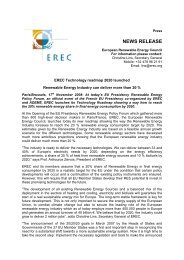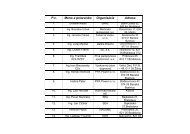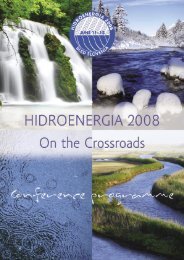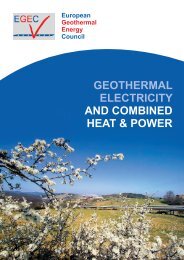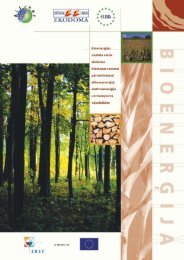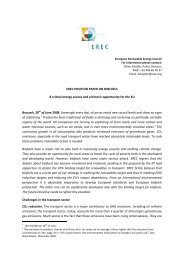Download the Geothermal energy brochure - European Renewable ...
Download the Geothermal energy brochure - European Renewable ...
Download the Geothermal energy brochure - European Renewable ...
Create successful ePaper yourself
Turn your PDF publications into a flip-book with our unique Google optimized e-Paper software.
<strong>European</strong> Geo<strong>the</strong>rmal<br />
Energy Council<br />
Objectives<br />
Who is egec ?<br />
The Voice of <strong>the</strong> Geo<strong>the</strong>rmal<br />
Sector in Europe<br />
development and implementation in <strong>the</strong> field of geo<strong>the</strong>rmal<br />
The aims of our organisation are to promote <strong>the</strong> use of<br />
<strong>energy</strong> use throughout Europe, and to foster Inter-<strong>European</strong><br />
geo<strong>the</strong>rmal <strong>energy</strong>, as follows :<br />
cooperation.<br />
Promote <strong>the</strong> market deployment of geo<strong>the</strong>rmal <strong>energy</strong> in<br />
By disseminating, through publications, meetings, discussions<br />
Europe and <strong>the</strong> export of <strong>European</strong> geo<strong>the</strong>rmal technology,<br />
or any o<strong>the</strong>r activity, <strong>the</strong> use of geo<strong>the</strong>rmal <strong>energy</strong>, as well as<br />
services and equipment to o<strong>the</strong>r parts of <strong>the</strong> world.<br />
its marketing, and to forward information on products and<br />
By exercising appropriate actions among <strong>European</strong> institutions<br />
to implement a legal and institutional framework and<br />
services to authorities, industry, and <strong>the</strong> public at large.<br />
By publicising, at <strong>European</strong> level, <strong>the</strong> opinions of researchers,<br />
fiscal instruments allowing geo<strong>the</strong>rmal sources to compete<br />
engineers, managers, and any o<strong>the</strong>r commentators or proponents<br />
on <strong>the</strong> use of geo<strong>the</strong>rmal <strong>energy</strong>, and bringing <strong>the</strong>m<br />
with conventional <strong>energy</strong> systems, and to secure economic<br />
support in consideration of <strong>the</strong> environmental benefits.<br />
to <strong>the</strong> attention of governments, national and international<br />
By encouraging R&D in <strong>the</strong> field of geo<strong>the</strong>rmal utilisation organisations, decision makers, and <strong>the</strong> public at large.<br />
of <strong>the</strong> existing resources in Europe and allowing <strong>the</strong> public<br />
at large to access to <strong>the</strong> R&D results and maximise <strong>the</strong><br />
utilisation of this renewable <strong>energy</strong>.<br />
By representing <strong>the</strong> interests of <strong>the</strong> <strong>European</strong> geo<strong>the</strong>rmal<br />
<strong>energy</strong> industry and users to governments and international<br />
organisations, with a view to improving business<br />
conditions for <strong>the</strong> industry.<br />
By co-operating with national geo<strong>the</strong>rmal associations, and<br />
in particular with <strong>the</strong> International Geo<strong>the</strong>rmal Association<br />
(IGA) and its <strong>European</strong> branch, and with any o<strong>the</strong>r asso-<br />
EGEC, <strong>the</strong> <strong>European</strong> Geo<strong>the</strong>rmal Energy Council, was founded in 1998 as an international<br />
non-profit association in Brussels. Its office is based nearby <strong>the</strong> <strong>European</strong> Institutions.<br />
EGEC has now members from 20 different <strong>European</strong> countries<br />
EGEC is a member of EREC, <strong>the</strong> <strong>European</strong> <strong>Renewable</strong> Energy Council,<br />
which groups toge<strong>the</strong>r all main <strong>European</strong> renewable <strong>energy</strong> industry<br />
and research associations under one roof, in <strong>the</strong> <strong>Renewable</strong> Energy House.<br />
EGEC is also a member of <strong>the</strong> International Geo<strong>the</strong>rmal Association (IGA).<br />
ciations promoting research and application of renewable<br />
<strong>energy</strong> sources, in order to join forces to achieve successful<br />
Contact details of EGEC<br />
Contact details of EREC<br />
<strong>European</strong> Geo<strong>the</strong>rmal Energy Council<br />
<strong>European</strong> <strong>Renewable</strong> Energy Council<br />
<strong>Renewable</strong> Energy House<br />
<strong>Renewable</strong> Energy House<br />
Rue d’Arlon 63-67 • 1040 Brussels • Belgium<br />
Rue d’Arlon 63-67 • B-1040 Brussels • Belgium<br />
Printed on ecologically friendly paper (chlorine free paper) - Design ACG Brussels<br />
Photo credits: EGEC, IGA<br />
Geo<strong>the</strong>rmal <strong>energy</strong> :<br />
from <strong>the</strong> earth, a renewable <strong>energy</strong> resource<br />
delivering heat and power 24 hours a day<br />
throughout <strong>the</strong> year, an <strong>energy</strong> resource nearly<br />
infinite and available all over <strong>the</strong> world.<br />
geo<strong>the</strong>rmal <strong>energy</strong><br />
T: + 32 2 400 10 24 F: + 32 2 400 10 10<br />
T: +32 2 546 1933 F: +32 2 546 1934<br />
E: info@egec.org I: www.egec.org<br />
E: erec@erec.org I: www.erec.org
Per definition, geo<strong>the</strong>rmal <strong>energy</strong> is <strong>the</strong> <strong>energy</strong> stored in form of heat below<br />
<strong>the</strong> earth’s surface. It has been used since antique times for heating, and for<br />
about 100 years also for electricity generation. Its potential is inexhaustible in<br />
human terms, comparable to that of <strong>the</strong> sun. Beside electric power generation, geo<strong>the</strong>rmal<br />
<strong>energy</strong> is today used for district heating, as well as for heating (and cooling)<br />
of individual buildings, including offices, shops, small residential houses, etc.<br />
Geo<strong>the</strong>rmal-generated electricity was first produced<br />
at Larderello, Italy, in 1904. Iceland, Italy, Turkey and<br />
France are <strong>the</strong> leading countries in Europe today.<br />
The largest geo<strong>the</strong>rmal district heating systems within Europe can be found in <strong>the</strong> Paris area in France, with<br />
Austria, Germany, Hungary, Italy, Poland, Slovakia and o<strong>the</strong>rs showing a substantial number of interesting<br />
geo<strong>the</strong>rmal district heating systems. Sweden, Switzerland, Germany and Austria are <strong>the</strong> leading countries in<br />
terms of market for geo<strong>the</strong>rmal heat pumps in Europe.<br />
State of <strong>the</strong> art technology<br />
Enhanced Geo<strong>the</strong>rmal System<br />
Geo<strong>the</strong>rmal power<br />
Today, geo<strong>the</strong>rmal power plants exist on<br />
every continent, at any place were reservoirs<br />
of steam or hot water can be found. They<br />
produce, with conventional technology, 820<br />
MW of electric power in <strong>the</strong> EU, around <strong>the</strong><br />
clock. The relevant resources are far from<br />
being fully developed, also in Europe. The<br />
concept of Enhanced Geo<strong>the</strong>rmal Systems<br />
(including <strong>the</strong> classical Hot-Dry-Rock-idea)<br />
is going to add a tremendous increase to<br />
<strong>the</strong> potential.<br />
Power plant<br />
Geo<strong>the</strong>rmal <strong>energy</strong>:<br />
<strong>the</strong> floor is yours !<br />
Geo<strong>the</strong>rmal District Heating<br />
District Heating Network<br />
Deep and directly<br />
The earth is full of <strong>energy</strong>. And virtually<br />
any temperature level in <strong>the</strong> underground<br />
can be used directly, for instance with deep<br />
boreholes. Did you know, that through<br />
deep boreholes almost 4500 MWth yet<br />
are installed in Europe? 4500 MWth for a<br />
clean environment. However, here again is<br />
valid: Only a small fraction of <strong>the</strong> resources<br />
is used currently.<br />
Borehole heat<br />
exchangers<br />
The shallow geo<strong>the</strong>rmal<br />
family<br />
Virtually every temperature level in <strong>the</strong><br />
underground can be used for geo<strong>the</strong>rmal<br />
<strong>energy</strong>, even if this means only ca. 3-15<br />
°C, as usual in <strong>the</strong> shallow underground<br />
in <strong>European</strong> climate. In most cases a heat<br />
pump is required here, and cooling can be<br />
supplied as well as heating. This technology<br />
provides again about 4500 MWth of<br />
heating capacity.<br />
Geo<strong>the</strong>rmal <strong>energy</strong>:<br />
a local answer,<br />
ecological and efficient,<br />
to reduce <strong>energy</strong> costs<br />
A renewable <strong>energy</strong>:<br />
an <strong>energy</strong> resource nearly infinite, delivering heat<br />
and power 24 hours a day throughout <strong>the</strong> year,<br />
and available all over <strong>the</strong> world<br />
<strong>energy</strong> supply by making use of <strong>the</strong> immense<br />
internal heat of <strong>the</strong> earth, and of <strong>the</strong> large<br />
<strong>the</strong>rmal storage capacity of <strong>the</strong> ground<br />
friendly for <strong>the</strong> environment: contribution<br />
to <strong>the</strong> reduction of CO 2 emissions<br />
very low visual impact - most of <strong>the</strong> infrastructure<br />
can be hidden beneath <strong>the</strong> ground<br />
Development<br />
potential of<br />
geo<strong>the</strong>rmal<br />
<strong>energy</strong>: today<br />
and for <strong>the</strong> future<br />
Concerning geo<strong>the</strong>rmal power production, <strong>the</strong><br />
installed electrical capacity in <strong>the</strong> <strong>European</strong> Union<br />
alone totalled about 850 MWe in 2007, producing<br />
more than 9000 GWh of electricity (with an excellent<br />
average load factor of 77 %!)<br />
In 2006, a total of more than 2 Mtoe has been supplied<br />
by geo<strong>the</strong>rmal heating alone. At <strong>the</strong> end of 2006, <strong>the</strong><br />
<strong>the</strong>rmal capacity amounted to 9 000 MWth. Unlike<br />
<strong>the</strong> o<strong>the</strong>r renewable <strong>energy</strong> sectors, geo<strong>the</strong>rmal sector<br />
growth is on <strong>the</strong> right track for reaching <strong>the</strong> EU<br />
White Paper objectives outlined for 2010.<br />
Roadmap: priorities for geo<strong>the</strong>rmal <strong>energy</strong><br />
The technology evolution can be expected in both sectors,<br />
power and heat, and towards increasing <strong>the</strong> usable geo<strong>the</strong>rmal<br />
potential, improving plant efficiency, and decreasing<br />
installation and operational costs:<br />
Enhanced geo<strong>the</strong>rmal Systems for Power<br />
and Combined Heat & Power<br />
“Classical” geo<strong>the</strong>rmal power and low/medium<br />
temperature power production<br />
MWel<br />
MWth<br />
Electricity<br />
7000<br />
6000<br />
5000<br />
4000<br />
3000<br />
2000<br />
1000<br />
0<br />
25000<br />
20000<br />
15000<br />
10000<br />
5000<br />
0<br />
A safe and controlled technology:<br />
not depending on climatic conditions<br />
proven and controlled technically: design, drillings,<br />
components (power plants, district heating, heat pumps)<br />
excellent feedback from leading countries<br />
An <strong>energy</strong> adaptable with high performance:<br />
an answer to different <strong>energy</strong> needs:<br />
electric power, heating, cooling, hot water<br />
modulated according to type of resource, to size and<br />
nature of equipments, and in order to meet demands<br />
for <strong>the</strong> heating sector: adaptable to old or new<br />
buildings, large or small, individual or district heating<br />
An economically sustainable <strong>energy</strong>:<br />
White paper<br />
starting point<br />
1995<br />
White paper<br />
starting point<br />
large reduction of <strong>energy</strong> invoice<br />
long-term durability of installations<br />
not sensitive to conventional <strong>energy</strong> prices -<br />
<strong>the</strong> earth will not send an invoice!<br />
2000<br />
Heating & Cooling<br />
1995<br />
1996<br />
1997<br />
1998<br />
Current<br />
trend<br />
2005<br />
Current<br />
trend<br />
Geo<strong>the</strong>rmal district heating<br />
Shallow geo<strong>the</strong>rmal & geo<strong>the</strong>rmal heat pumps<br />
2010<br />
Miscellaneous: innovative concept<br />
(agriculture, drying…), desalination,<br />
absorption cooling, storage of heat or cold,<br />
advanced control systems<br />
EGEC target<br />
2020<br />
EGEC target<br />
2010 White paper<br />
target<br />
1999<br />
2000<br />
2003<br />
2004<br />
2005<br />
2020<br />
EGEC target<br />
2010<br />
White paper<br />
target<br />
2006<br />
2007<br />
2008<br />
2009<br />
2010<br />
EGEC target<br />
2020<br />
2020<br />
geo<strong>the</strong>rmal <strong>energy</strong>


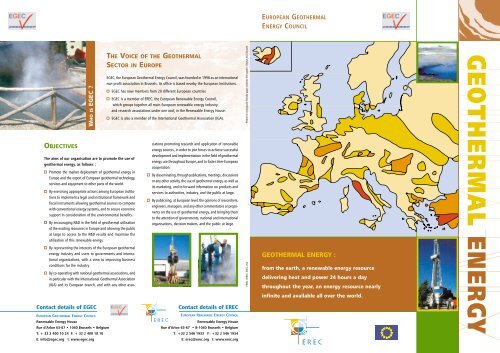

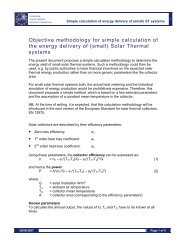
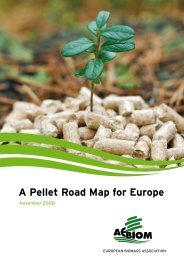
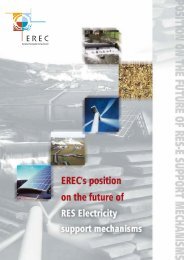

![Energy [R]evolution - Greenpeace](https://img.yumpu.com/47174859/1/184x260/energy-revolution-greenpeace.jpg?quality=85)
